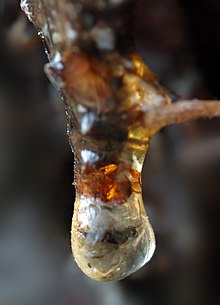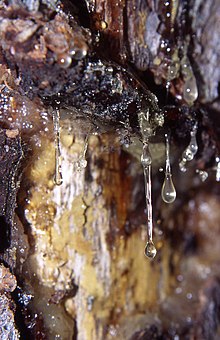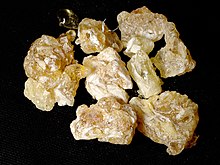Resin

Resin is a hydrocarbon secretion of many plants, particularly coniferous trees. It is valued for its chemical constituents and uses, such as varnishes and adhesives, as an important source of raw materials for organic synthesis, or for incense and perfume. Fossilized resins are the source of amber. Resins are also a material in nail polish.
The term is also used for synthetic substances of similar properties. Resins have a very long history and are mentioned by both ancient Greek Theophrastus and ancient Roman Pliny the Elder, especially as the forms known as frankincense and myrrh. They were highly prized substances used for many purposes, especially perfumery and as incense in religious rites.
Chemistry

The resin produced by most plants is a viscous liquid, composed mainly of volatile fluid terpenes, with lesser components of dissolved non-volatile solids which make resin thick and sticky. The most common terpenes in resin are the bicyclic terpenes alpha-pinene, beta-pinene, delta-3 carene and sabinene, the monocyclic terpenes limonene and terpinolene, and smaller amounts of the tricyclic sesquiterpenes, longifolene, caryophyllene and delta-cadinene. Some resins also contain a high proportion of resin acids. The individual components of resin can be separated by fractional distillation
A few plants produce resins with different compositions, most notably Jeffrey Pine and Gray Pine, the volatile components of which are largely pure n-heptane with little or no terpenes. The exceptional purity of the n-heptane distilled from Jeffrey Pine resin, unmixed with other isomers of heptane, led to its being used as the defining zero point on the octane rating scale of petrol quality. Because heptane is highly flammable, distillation of resins containing it is very dangerous. Some resin distilleries in California exploded because they mistook Jeffrey Pine for the similar but terpene-producing Ponderosa Pine. At the time the two pines were considered to be the same species of pine; they were only classified as separate species in 1853.
Some resins when soft are known as 'oleo-resins', and when containing benzoic acid or cinnamic acid they are called balsams. Other resinous products in their natural condition are a mix with gum or mucilaginous substances and known as gum resins. Many compound resins have distinct and characteristic odors, from their admixture with essential oils.
Certain resins are obtained in a fossilized condition, amber being the most notable instance of this class; African copal and the kauri gum of New Zealand are also procured in a semi-fossil condition.
Derivatives

Solidified resin from which the volatile terpene components have been removed by distillation is known as rosin. Typical rosin is a transparent or translucent mass, with a vitreous fracture and a faintly yellow or brown colour, non-odorous or having only a slight turpentine odour and taste.
It is insoluble in water, mostly soluble in alcohol, essential oils, ether and hot fatty oils, and softens and melts under the influence of heat, is not capable of sublimation, and burns with a bright but smoky flame.
This comprises a complex mixture of different substances including organic acids named the resin acids. These are closely related to the terpenes, and derive from them through partial oxidation. Resin acids can be dissolved in alkalis to form resin soaps, from which the purified resin acids are regenerated by treatment with acids. Examples of resin acids are abietic acid (sylvic acid), C20H30O2, plicatic acid contained in cedar, and pimaric acid, C20H35O2, a constituent of galipot resin. Abietic acid can also be extracted from rosin by means of hot alcohol; it crystallizes in leaflets, and on oxidation yields trimellitic acid, isophthalic acid and terebic acid. Pimaric acid closely resembles abietic acid into which it passes when distilled in a vacuum; it has been supposed to consist of three isomers.
Synthetic resins
Synthetic resins are materials with similar properties to natural resins—viscous liquids capable of hardening. They are typically manufactured by esterification or soaping of organic compounds. The classic variety is epoxy resin, manufactured through polymerization-polyaddition or polycondensation reactions, used as a thermoset polymer for adhesives and composites. Epoxy resin is two times stronger than concrete, seamless and waterproof. Accordingly, it has been mainly in use for industrial flooring purposes since the 1960s. Since 2000, however, epoxy and polyurethane resins are used in interiors as well, mainly in Western Europe.
One more category, which constitutes 75% of resins used, is unsaturated polyester resin. Ion exchange resin is another important class with application in water purification and catalysis of organic reactions. See also AT-10 resin, melamine resin. Another synthetic polymer is also sometimes called by the same suffix, acetal resin. By contrast with the other synthetics, however, it has a simple chain structure with the repeat unit of form -[CH2O]-.
Uses

The hard transparent resins, such as the copals, dammars, mastic and sandarac, are principally used for varnishes and cement, while the softer odoriferous oleo-resins (frankincense, elemi, turpentine, copaiba) and gum resins containing essential oils (ammoniacum, asafoetida, gamboge, myrrh, and scammony) are more largely used for therapeutic purposes and incense.
Resin in the form of rosin is used for the upkeep of bows for stringed instruments (i.e. violin, viola, cello, double bass), because of its quality for adding friction to the hair. Ballet dancers may apply crushed rosin to their shoes to increase grip on a slippery floor.
Resin has also been used as a medium for sculpture by artists such as Eva Hesse, and in other types of artwork.
Also, resin is used in some skateboard decks. It makes the skateboard more durable, making it less likely to get pressure-related cracks, chipping, or breaking in half.
Conservators use resins to consolidate fragile items such as bone found on archaeological sites. The resin acts to bind the fragile material inside its molecular structure. In Pompeii, resin is now used instead of plaster to recreate the bodies of Mount Vesuvius' victims, because it is more durable.
Smoked marijuana cakes up in smoke inlet pipes and can be scraped off and smoked again. This releases what is left of the THC that became trapped through moisture drip-off and smoke settling.
See also
- Biodegradable
- Kino (plant) - a plant gum similar to resin
- Pitch (resin)
- Polyresin - a hard, synthetic resin for casting in molds
- Resin casting
- Resin extraction
- Rosin - a solid form of natural resin
